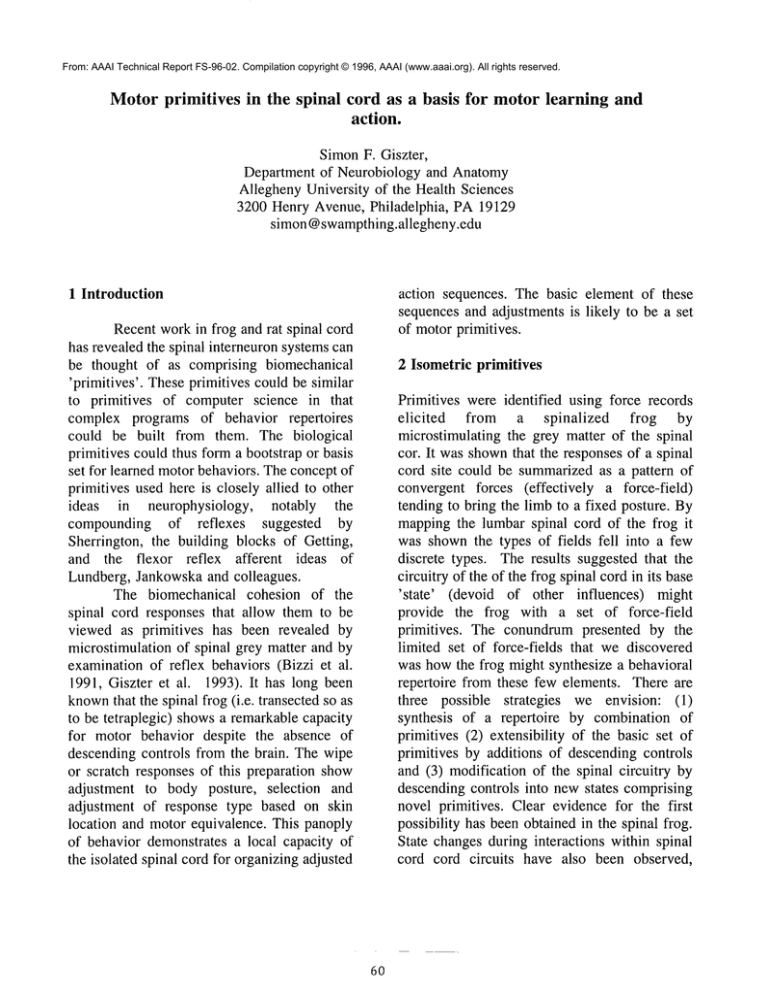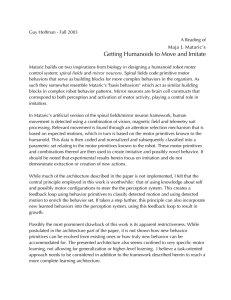Document 13784623
advertisement

From: AAAI Technical Report FS-96-02. Compilation copyright © 1996, AAAI (www.aaai.org). All rights reserved. Motor primitives in the spinal cord as a basis for motor learning action. and SimonF. Giszter, Department of Neurobiology and Anatomy Allegheny University of the Health Sciences 3200 Henry Avenue, Philadelphia, PA 19129 simon @swampthing,allegheny.edu action sequences. The basic element of these sequences and adjustments is likely to be a set of motorprimitives. 1 Introduction Recent workin frog and rat spinal cord has revealed the spinal interneuron systemscan be thought of as comprising biomechanical ’primitives’. Theseprimitives could be similar to primitives of computer science in that complex programs of behavior repertoires could be built from them. The biological primitives could thus form a bootstrap or basis set for learned motorbehaviors. Theconcept of primitives used here is closely allied to other ideas in neurophysiology, notably the compounding of reflexes suggested by Sherrington, the building blocks of Getting, and the flexor reflex afferent ideas of Lundberg, Jankowskaand colleagues. The biomechanical cohesion of the spinal cord responses that allow them to be viewed as primitives has been revealed by microstimulation of spinal grey matter and by examination of reflex behaviors (Bizzi et al. 1991, Giszter et al. 1993). It has long been knownthat the spinal frog (i.e. transected so as to be tetraplegic) showsa remarkable capacity for motor behavior despite the absence of descending controls from the brain. The wipe or scratch responses of this preparation show adjustment to body posture, selection and adjustment of response type based on skin location and motor equivalence. This panoply of behavior demonstrates a local capacity of the isolated spinal cord for organizing adjusted 2 Isometric primitives Primitives were identified using force records elicited from a spinalized frog by microstimulating the grey matter of the spinal cor. It was shownthat the responses of a spinal cord site could be summarizedas a pattern of convergent forces (effectively a force-field) tending to bring the limb to a fixed posture. By mappingthe lumbar spinal cord of the frog it was shownthe types of fields fell into a few discrete types. The results suggested that the circuitry of the of the frog spinal cord in its base ’state’ (devoid of other influences) might provide the frog with a set of force-field primitives. The conundrum presented by the limited set of force-fields that we discovered was howthe frog might synthesize a behavioral repertoire from these few elements. There are three possible strategies we envision: (1) synthesis of a repertoire by combination of primitives (2) extensibility of the basic set primitives by additions of descending controls and (3) modification of the spinal circuitry descending controls into newstates comprising novel primitives. Clear evidence for the first possibility has been obtained in the spinal flog. State changes during interactions within spinal cord cord circuits have also been observed, 6O suggesting that items 2 and 3 should not be forgotten. of descending controls the local spinal cord reflexes form the primary action and decision system present. Simulation of frog reflexes showed that some exclusion mechanisms were likely to be necessaryin order to generate useful action sequences in the face of multiple conflicting stimuli (Giszter, 1994). A Maestype (Maes1991) action selection was successful reproducing many aspects of frog reflex organization. These results makeit likely that vector summationof primitives in the isolated spinal cord is overseenby reflex action selection mechanisms that include exclusion rules and winner take all. Conceivably primitives could even incorporate someof these action selection rules within their circuitry. This presents difficulties for descendingcontrols interacting with reflex systemsand primitives. It is possible that descending control could suppress these exclusion mechanisms as necessary during voluntary action selection and in motorlearning. Alternatively the descending and local controls might operate morecooperatively. The fact that in some dire circumstances voluntary behavior can be ’interrupted’ by protective reflexes and in other dire situations reflexes are suppressed despite physical damage incurred by the organism taken together suggest that, at least someof the time, cooperation is the rule. 3 Vector summationof primitives Bystimulating spinal cord sites that generated qualitatively different force-fields, both in isolation and in conjunction, we were able to show that vector summation of force-fields elicited by different sites’ responses could occur. In fact 85%of sites showedthis pattern of summation(Mussa-Ivaldi et al. 1995). The other responses were, in general, winner take all. The preponderence of summationresponses suggested that the primitives could usually be simply combined to synthesize new field structures. The possibilities for such a system of force-fields and a summationmechanismfor forming a basis set for synthesis of arbitrary field structures were demonstrated by Mussa-Ivaldi 1992 and Mussa-Ivaldi and Giszter 1992. One difference between theory and practical biology was observed however. Circulating (non-conservative) force-fields were conspicuously absent from the biological data. For arbitrary field synthesis circulating fields were necessary. This implied that either (a) the frog repertoire did not admit the existence of sometypes of fields or that (b) additional mechanisms were required to synthesize arbitrary fields. The absence of circulating fields and the use of purely conservative fields or controllers has been shownto confer stability properties in passive environments (Colgate and Hogan1989). 5 Dynamicaspects of primitives The organizational scheme discussed thus far was based strictly on isometric measurementin which the limb was held immobile at each test location. The full interaction of muscle properties and afferent controls with the spinal cord output which occurs in the presence of limb dynamics was missing. We recently conductedexperimentsto remedythis (Giszter et al. 1996 submitted) and the results extend and augment the scheme discussed above. Weused a small ’phantom’ haptic interface robot to generate simulated elastic or viscous fields for the frog limb. We were able to use this 4 Reflex roles and executive hierarchy The 15%of non summingfields observed in the spinal cord maybe partly explained by the role of force-field primitives in reflex behaviors and the requirements of these behaviors. Thenotion of local action selection, rules and timing is foundin both robotics (e.g. Brooks, Maes) and in biology. In the absence 61 apparatus to measure force generation after a movementand to examine limb kinematics in different environments.Twosignificant results were obtained using this system which impact on the concept of motor primitives as a basis for motor learning. The experiments suggested the existence of a timer and of a second primitive type. 8 A new primitive type The adjustment to environmental compliance that we observed could represent several differing types of adjustments. Surprisingly, the adjustments appeared to be parsimoniously represented by the addition of a second force-field type. The adjustment was well represented by a zero stiffness (constant force) field which was oriented at each point in the samedirection as the elastic field measuredin isometric conditions. This field’s amplitude was regulated in response to limb motion. These fields are presumably activated and controlled only during the movement,and for the duration specified by the putative timer. The advantage of this schemeis probably one of stability. The inelastic (and perhaps occasionally nonconservativefield) is activated briefly, and thus the risk of unstable behavior in passive environments is short-lived. The scheme may have analogies to sliding modecontrol (Slotine 1984) 6 A timer function The force responses in different environments always peaked at approximately the same time regardless of mechanical conditions in which the limb founditself. Despitealterations to the natural frequency of the frog/robot system intrinsic timing was preserved. To us this suggests that an intrinsic timer should be associated with the motor primitive system either individually (one timer per primitive) as an ensemble (a single timer). This is keeping with ideas in pattern generation in the spinal cord. This association of primitives to a timer provides a time segmentation at the spinal level and quantizes action. 9 Motor learning primitives using spinal motor 7 Adjustment to environment Based on our recent work, the addition of dynamic control and nonconservative fields to the biological repertoire of motor primitive force-fields is necessary. This forces a re-examination of the appropriate learning architecture. Basis field approaches are still viable but must incorporate the timers and nonconservativefields in an effective way. Recent experiments with the robot also demonstrated considerably adjustment.The force-field measuredafter a period of motion was regulated in amplitude based on environmentproperties. In stiffer environments more force was produced. The motor primitive thus encapsulated a set of dynamiccontrols. This suggests that a certain amountof control of the interaction with the environment and dynamics can be relegated to the primitive. Thecaveat is that any motorlearning using the primitive must include some aspects of this encapsulation in its computation to use the primitive effectively. 10 Conclusions: a bootstrap or a basis set? The motor primitive concept is a useful one, especially at the reflex level. The force-field approximation model of motor learning is powerful and informative. However,despite our advances in understanding spinal system organization, the relationship of these two sets 62 capture vector patterns. Biol. Cybernetics 6’7 (pp.479--489). of ideas is still unclear in the intact organism. Theprimitives found at the spinal level maybe directly incorporatedin a ’lexicon’ for ’higher’ motor learning. Alternatively they mayform a waystation that was used briefly in evolution and during ontogeny to bootstrap stable learning systems which ultimately produce the collection of adult motorprocesses wethink of as motor learning (see e.g. Sanger 1994). Acknowledgements: NS34640 supported MussaIvaldi FA. and Giszter S.F. (1992).Vector field approximation: a computational paradigm for motorcontrol and learning. Biol. Cybernetics 67 (pp.491--500). Sanger T D (1994) Ph.D. Thesis. Department Brain and Cognitive Science MIT. by NIH Slotine J-J.E. Sliding Controller Design for NonlinearSystems. Int J. Control, 40, 2. References Tresch M. and Bizzi E. (1995). Convergent force-fields in the rat spinal cord. Soc Neurosci Abstr 21: Abstr 274.6 (p. 682). Bizzi, E., Mussa-Ivaldi F.A. and Giszter S.F.. (1990). Computationsunderlying the execution of movement: A biological perspective. Science 253:pp. 287--291. Colgate E., and HoganN. (1989) An analysis of contact instability in terms of passive physical equivalents. IEEE Proc Int Conf Robot Automat pp. 404--409. Giszter S.F., Mussa-Ivaldi F.A. and Bizzi, E.. (1993). ConvergentForce-fields organized the frog’s spinal cord. J. Neurosci 13(2):(pp. 467--491). Giszter S.F.(1994). Reinforcement tuning action synthesis and selection in a virtual frog. In Fromanimals to animats 3: Proc. Third Int’l Conf on Simulation of Adaptive Behavior (pp. 291--301). Maes P. (1991). Situated agents can have goals. In Designing AutonomousAgents ed. Maes(pp. 49--70). MussaIvaldi FA. (1992). Frombasis functions to basis fields: Using vector primitives to 63






